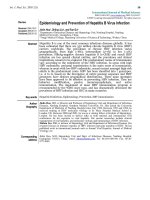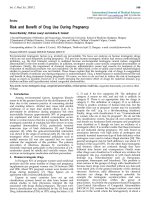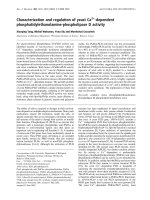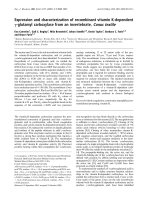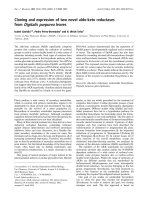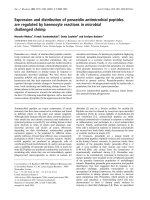Báo cáo y học: "Risk and Benefit of Drug Use During Pregnancy"
Bạn đang xem bản rút gọn của tài liệu. Xem và tải ngay bản đầy đủ của tài liệu tại đây (278.15 KB, 7 trang )
Int. J. Med. Sci. 2005 2
100
International Journal of Medical Sciences
ISSN 1449-1907 www.medsci.org 2005 2(3):100-106
©2005 Ivyspring International Publisher. All rights reserved
Review
Risk and Benefit of Drug Use During Pregnancy
Ferenc Bánhidy
1
, R.Brian Lowry
2
and Andrew E. Czeizel
3
1 Second Department of Obstetrics and Gynecology, Semmelweis University, School of Medicine, Budapest, Hungary
2 Department of Medical Genetics, University of Calgary and Alberta, Children’s Hospital Calgary, Canada
3 Foundation for the Community Control of Hereditary Diseases, Budapest, Hungary
Corresponding address: Dr. Andrew E.Czeizel, 1026 Budapest, Törökvész lejtő 32, Hungary. e-mail:
Received: 2005.05.01; Accepted: 2005.06.03; Published: 2005.07.01
Environmental teratogenic factors (e.g. alcohol) are preventable. We focus our analysis on human teratogenic drugs
which are not used frequently during pregnancy. The previous human teratogenic studies had serious methodological
problems, e.g. the first trimester concept is outdated because environmental teratogens cannot induce congenital
abnormalities in the first month of gestation. In addition, teratogens usually cause specific congenital abnormalities or
syndromes. Finally, the importance of chemical structures, administrative routes and reasons for treatment at the
evaluation of medicinal products was not considered. On the other hand, in the so-called case-control epidemiological
studies in general recall bias was not limited. These biases explain that the teratogenic risk of drugs is exaggerated,
while the benefit of medicine use during pregnancy is underestimated. Thus, a better balance is needed between the risk
and benefit of drug treatments during pregnancy. Of course, we have to do our best to reduce the risk of teratogenic
drugs as much as possible, however, it is worth stressing the preventive effect of drugs for maternal diseases (e.g.
diabetes mellitus and hyperthermia) related congenital abnormalities.
Key words: human teratogenic drugs, congenital abnormalities, critical period, recall bias, congenital abnormality, preventive effect
of drugs.
1. Introduction
Among environmental factors, dangerous lifestyle
seems to be the greatest hazard for the development of the
fetus due to the common practice of consuming alcohol
and smoking tobacco. Alcohol may cause fetal alcohol
syndrome or at least fetal alcohol effects [1,2]. It is
preventable by abstinence during pregnancy but often
unavoidable because approximately 50% of pregnancies
are unplanned and hence alcohol consumption occurs
before a woman knows that she is pregnant. Recently the
teratogenic potential of smoking has been shown in some
congenital abnormalities (CAs), particularly terminal
transverse type of limb deficiencies [3] and Poland
sequence [4], while the gene-environmental interaction
was shown in the origin of orofacial clefts [5]. The role of
teratogenic effect of environmental pollutants such as
methyl mercury [6] was also reported but we cannot
estimate the magnitude of this problem. The primary
prevention of infectious diseases by vaccination is
extremely important particularly in the prevention of CA-
syndromes caused by rubella and varicella viruses. Here
we focus on teratogenic medication and their prevention.
2. Human teratogenic drugs
In Hungary 92% of pregnant women used medicinal
products and the mean number of drugs and pregnancy
supplements per pregnant women was 3.4 between 1980
and 1996. About 70% pregnant women were treated with
drugs during pregnancy [7]. These figures are in
agreement with a recent publication [8].
Experts in many countries have set up risk
classification systems based on data from human and
animal studies to help physicians interpret the risk
associated with drugs during pregnancy. The most well-
known classification was introduced by the US Food and
Drug Administration (FDA) in 1979, using the letters A, B,
C, D and X for five categories [9]. The definition of
category A means no risk, and any risk is unlikely in
category B. There is no appropriate data for drugs in
category C. The definition of category D is as follows:
“There is positive evidence of human fetal risk, but the
benefits from use in pregnant women may be acceptable
despite the risk” (e.g. in a life-threatening situation).
Finally, drugs with classification X are “Contraindicated
in women who are or may be pregnant”. We do not like
this classification system, because all oral contraceptives
and female sex hormones (both estrogens and progestins)
were classified as X though we have no evidence of a
teratogenic effect. It is another matter that these hormones
are not indicated during pregnancy. We only found an
association between very high doses of oestrogens and
unimelic terminal transverse type of limb deficiency when
oestrogens were used to induce illegal abortion [10]. This
general teratogenic risk for limb deficiency was about 1%
instead of the usual 0.05%. On the other hand teratogenic
and fetotoxic effects are confused though they have
different time factors and consequences. Finally some
other drugs were classified as X without any evidence for
teratogenic risk (e.g. clomiphene) or with much debated
findings (e.g. benzodiazepine such as flurazepam,
quazepam, temazepam and triazolam). This problem is
more serious in the groups of drugs with classification D
because many drugs were classified without any data and
were based only on the general similarity of the chemical
structure. However, mild differences in the chemical
structure can change the teratogenic potential, for
example the teratogenic oxytetracyclines and non-
teratogenic doxycycyline within the group of
tetracyclines. At present the population-based Hungarian
Case-Control Surveillance of Congenital Abnormalities
(HCCSCA) [11] contains the largest national case-control
data set in the world where the teratogenicity of about a
Int. J. Med. Sci. 2005 2
101
hundred drugs was studied. Our findings do not confirm
the teratogenic risk of benzodiazepines such as diazepam
[12], chlordiazepoxide [13], nitrazepam, medazepam,
tofisopam, aplrazolum and clonazepam [14]. The
teratogenic effect of diazepam and some other
benzodiazepines was not confirmed after self-poisoning
(i.e. suicide attempt) with extremely large doses [15,16].
The teratogenic effect of barbitals [17], furosemide [18],
aminoglycoside antibiotics [19] and povidone-iodine [20]
was also not found. After the negative findings of our
studies we cannot accept the risk estimation of the FDA
classification system. Similar opinions were stated by
other experts as well, therefore two other drug
classification systems have been developed in Sweden [21]
and Australia [22].
There are about 8,200 medicinal products in the
Hungarian market, however, the number of chemical
substances, i.e. generic drugs with human teratogenic risk
is limited. Table 1 shows drugs with high and moderate
teratogenic risk. Thalidomide was never marketed in
Hungary, however, it is used again in some countries
(e.g., Brazil) as an effective drug for leprosy and other
diseases. Androgenic hormones are not indicated in the
treatment of pregnant women, nevertheless some women
used these drugs at the beginning of their unplanned
pregnancies due to their body building activity. At
present isotretinoin and etretinate are considered the most
teratogenic risk used for the treatment of acne and
psoriasis in Hungary, therefore an effective campaign was
organized to prevent their use during pregnancy. The
coumarin derivatives cause the largest clinical problem
because pregnant women with a previous thrombosis
history frequently need treatment. However, it is possible
to change the treatment protocol and use heparin instead
of coumarin derivatives in the early pregnancy because
the latter drugs are teratogenic in the third and fourth
months of gestation. Oxytetracyclines are also teratogenic,
but these products are now not on the market. The use of
oxytetracyclines was relatively frequent in Hungarian
pregnant women, thus we were able to show that Tetran
®
induced – other than staining of deciduous teeth – a
characteristic pattern of multiple CA [23].On the other
hand doxycycline is not teratogenic [24]. The use of D-
penicillamine (e.g. in Wilson disease) rarely occurs and it
may cause cutis laxa, not a severe CA. In addition this CA
can be diminished by the parallel use of zinc.
Diethylstilbestrol was also withdrawn from the market.
The proportion of women treated with drugs with high
and moderate teratogenic risk during the study pregnancy
was 0.8% and 0.4% in the group of cases with CAs and
controls without CAs in the data set of the HCCSCA,
1980-2002, respectively.
The list of drugs with low and very low teratogenic risk
is longer (Table 2), though the names of drugs with
fetotoxic effects, e.g., chlorothiazide, angiotensin-
converting enzyme inhibitors, beta-adrenergic blocking
agents, reversible goiter inducing potassium iodine, etc,
are not mentioned. There is a long list of antineoplastic
and anticonvulsant drugs which may be needed in
pregnant women with cancer or epilepsy. At present some
of them are not on the market, but most drugs in this list
have a teratogenic risk between 2 and 5%. Ergotamine and
quinine derivatives were used relatively frequent. Among
oestrogens and retinol (vitamin A), only high dose
treatments are considered. It is worth mentioning that we
had three mothers who were treated by 50,000 and one
with 100,000 IU doses of vitamin A daily in the first and
second months of gestation, and later they delivered
newborn infants without any CAs [25]. Our finding is in
agreement with the conclusion of the European Network
of the Teratology Information Services, whose data set did
not provide evidence for an increased risk of major CAs
associated with high vitamin A intake (10,000 IU per day
or more) during the organogenetic period of embryo [26].
Here we discuss three problems at the evaluation of
human teratogenic risk of drugs.
I. Low scientific quality of previous human teratogenic
studies
Unfortunately the scientific quality of most previous
studies regarding risk estimation of teratogenic
medications was low due to some methodological
problems.
Time factor: first trimester concept is outdated
The first trimester of pregnancy was considered as
the critical period of most major CAs. This supposition is
unscientific and outdated [27].
At present gestation age is calculated from the first
day of the last menstrual period. Thus, “pregnant
women” are not pregnant in the first two weeks of their
pregnancies. The third week covers the preimplantation
period when the zygote goes from the external end of the
Fallopian tube to the uterus. The fourth week comprises
the implantation period when the blastocyst finds its site
in the uterus. However, the zygotes and blastocysts have
continuous mitoses producing totipotent stem cells during
this period. Serious damage can cause their death, but
after limited damage they have a complete recovery.
These facts explain the rule of “all-or-nothing effect” or in
other words the consequence of these damages have only
two outcomes: complete loss of zygotes/blastocysts
(which causes only some delay in the seemingly
menstrual bleeding) or healthy birth.
In conclusion, human teratogenic drugs cannot
induce CA in the first month of gestation because the
specific activation of DNA in the stem cells and the so-
called differentiation of specific cells, organs and body
forms starts on the 29th day of gestation (or on the 15th
postconception day). The 29th day of gestation overlaps
with the first days of missing menstrual bleeding when
women in general can recognize the pregnancy. Thus, it is
necessary to know that before the first missed menstrual
bleeding, environmental factors cannot induce CAs. The
main organ-forming period lasts from the 29th day to the
70th day of gestation. The evaluation of the first trimester
is therefore a serious methodological error, only the second
and third months represent the critical period of most major
CAs. On the other hand we know that the critical period of
some CAs exceeds the end of third month, e.g., the critical
period of posterior cleft palate and hypospadias covers
the 12th-14th and 14th-16th weeks of gestation, while the
critical period of undescended testis and patent ductus
arteriosus is 7 to 9 months and 9 to 10 months,
respectively. Thus, the optimal approach is to consider the
specific critical period of each CA [7] separately.
Specificity of teratogens
It is not worth studying the total group of CAs
because CAs have different etiological backgrounds.
Therefore we have to focus our analysis on specific CAs
since teratogenic drugs induce specific CAs without
affecting other CAs and overall rates. Thus, we have to do
Int. J. Med. Sci. 2005 2
102
our best to develop groups of CAs as homogeneous as
possible. In addition the most teratogenic drugs cause
specific CA syndromes with a characteristic pattern of
component CAs. This phenomenon explains the
delineation of fetal alcohol, radiation, rubella, hydantoin-
phenytoin, warfarin-coumarin, accutane, etc. syndromes.
This rule helps us to identify the cause of specific CA-
syndrome, e.g., if a case is affected with cleft lip and nail
hypoplasia, we can diagnose hydantoin (phenytoin) CA-
syndrome in a baby of an epileptic mother who has been
treated with this drug.
Another common and serious methodological error
occurs when isolated (single) and multiple (syndromic)
manifestations of the seemingly same CAs are combined
and evaluated together. Most isolated CAs have a
complex etiology based on some polygenic predisposition
which is triggered by environmental risk factors. The
seemingly similar component CAs within
multimalformed or syndromic cases are caused by
chromosomal aberrations, gene mutations or teratogens
[28]. We can easily prove the different etiopathogenetic
background of isolated and multiple CAs by
epidemiological methods. For example, isolated cleft lip
has a left sided and male predominance while component
cleft lip in syndromic cases has no side predominance and
the sex ratio corresponds to the usual population figure
[29]. Thus, it is an important rule to evaluate the isolated
and multiple manifestations of the same CA separately.
The importance of different chemical structures, administrative
routes and reasons for treatment at the teratogenic evaluation of
medicinal products was not considered
In general, similar drugs were evaluated together
such as penicillins, tetracyclines, cephalosporins (or
sometimes as “antibiotics”) and sulfonamides in the past.
This approach is not correct because each drug within
these groups has different chemical structure. As we
mentioned previously within the group of tetracyclines,
oxytetracylines [23] were teratogenic while doxycyclines
[24] were not teratogenic. At the evaluation of seven orally
used sulfonamides, only two showed teratogenic
potential, and they induced different CAs [30].
Our studies showed the importance of interaction of
different drugs. We were not able to find a clinically
important teratogenic effect after the use of oral
metronidazole [31] and the topical miconazole treatment
resulted in an obvious negative finding [32]. Nevertheless,
the vaginal use of the combination of these two drugs
increased the risk for poly/syndactyly six fold [33].
Our analyses also demonstrated that it is necessary
to differentiate the administrative route of drugs and their
teratogenic potential. We should therefore evaluate the
use of the same drugs (e.g., corticosteroids and antifungal
agents) according to oral, parenteral, topical (skin,
vaginal, eye and ear) and inhaled aerosol treatments
separately.
Finally it is necessary to differentiate drugs and
pregnancy supplements within medicinal products. Drugs
are used for the treatment of maternal diseases and
pregnancy complications during pregnancy while
pregnancy supplements such as folic acid, other vitamins
[34], iron, calcium, multivitamins, etc are given to prevent
pregnancy complications and unsuccessful pregnancy
outcomes particularly CAs. These opposite effects of
medicinal products have to be considered when
evaluating the drugs.
II. Recall bias
The birth of an infant with a CA is a serious
traumatic event for most mothers, who therefore try to
find a causal explanation such as drug use during
pregnancy, something that does not occur after the birth
of a healthy infant. Thus the mothers of babies affected
with CAs are continually thinking of possible dangerous
environmental factors and when asked about the history
of their pregnancy, give a long list of supposed agents. On
the other hand the mothers of healthy babies are thinking
of the present and future of their babies and are likely to
forget events during the pregnancy. Retrospective (i.e.,
after the birth) maternal self-reported information
therefore is different in the groups of case and control
mothers and this recall bias can mimic an increased risk of
drugs in the CA-groups up to an odds ratio of 1.9 (35).
Thus a higher risk of less than 1.9 should be interpreted
cautiously. In addition, it is possible to reduce recall bias.
Firstly, we evaluate 25 CA-groups and we expect a
higher occurrence of one or some CA-groups after the use
of the given drug due to the specificity of teratogens.
Recall bias may act for all CAs similarly.
Secondly, the use of the drug under study is
evaluated during the critical period of CA formation, in
general the second and third months of gestation. We may
suppose that the teratogenic effect of the drug is shown
only during this period because we expect an
underreporting of exposure in both the critical and non-
critical periods of CA formation in the mothers of healthy
babies, i.e., in the population control group.
Thirdly, an independent and prospective source of
drug exposure data, e.g., the medically recorded data in
the prenatal logbook may serve as a gold standard. Our
validation study, however, showed that a small group of
pregnant women (2.4%) did not use prescribed and
medically recorded drugs or they shortened the duration
of treatment due to the supposed teratogenic risk [36].
Another independent and prospective source of drug
exposure can be found in pharmacy records [37].
Fourthly, it is worth using a patient control group
including mothers of cases with other CAs. In our
HCCSCA system, cases with Down syndrome are used as
patient controls [11] because the cause of this numerical
chromosomal aberration (trisomy 21) is not connected
with the teratogenic effect of agents during pregnancy,
and particularly in the critical period of most CA
formation, i.e., during the second and third months of
gestation.
Fifthly, “true” teratogens such as rubella virus,
radiation, alcohol, hydantoin-phenytoin, warfarin-
coumarin, accutane, etc., cause multiple CA with a
characteristic pattern of CAs. Thus multimalformed cases
need a special and detailed analysis [28] because these
data are not distorted by recall bias. Another group of
teratogens plays a role as trigger factors in the origin of
isolated CAs based on polygenic-environmental
interaction, i.e. multifactorial etiology.
III. Teratogenic risk of drugs is exaggerated.
The exaggeration of drug teratogenicity can be
explained by several factors.
1. At present the average number of children per
family in Hungary is about 1.3 compared to 11 in the 19th
century. In the past, the social role of females was the
“reproduction” of human beings. Now they take part in
the social “production” outside their homes similar to
Int. J. Med. Sci. 2005 2
103
males but they have to fulfill their traditional role of
reproduction as well. A malformed or disabled child
curtails their social activity hence the emphasis on having
a healthy baby.
2. The positive findings of animal investigations are
frequently extrapolated for the human fetus contrary to
the well-known species specificity.
3. The previous teratologic studies had several
methodological weaknesses and recall bias which are
summarized above and which resulted in false positive
findings.
4. The editors of scientific periodicals have an
aversion to publishing papers with negative results, but
are happy to publish selected case reports and the positive
findings of animal and human epidemiological studies.
This publication bias distorts the thinking of experts as
well as the general population.
5. The false balance of risk and benefit of drug use
during pregnancy is seriously augmented by the
defensive policy of pharmaceutical companies and
regulatory agencies which are gradually labeling most
drugs with the recommendations to avoid their use
during pregnancy, at least in “the first trimester”.
6. This unbalanced opinion is amplified by a self
defensive attitude of some doctors and is partly
understandable. They may not be well informed and may
exaggerate the risk by relying on manufacturers drug
pamphlets. They may also be thinking about possible law
suits and are therefore over cautious forgetting that the
chance of any pregnancy ending with a baby who has a
major CA is approximately 3%.
The exaggeration of teratogenic risk of medicinal
products causes several hazards.
First, many pregnant women do not get the
necessary drug treatment and it results in serious
consequences both for the mothers and their fetuses. If
influenza [38] and other acute infectious diseases of
respiratory system [39] with high fever in early pregnancy
are not treated by appropriate methods including drugs,
therefore the teratogenic effect of hyperthermia can
induce hyperthermic embryopathy (Table 3), among
others, neural-tube defects. In Hungary, about 40 % of
pregnant women have some sexually transmitted
infections and/or diseases in their genital organs [40].
Most medical doctors do not dare to treat them, therefore
the ascending infections are followed by preterm birth
and serious intrauterine infection of the fetus. Our study
showed that the fetuses of inappropriately or untreated
asthmatic pregnant women have a higher risk for
intrauterine growth retardation [41].
Second, many planned and wanted pregnancies are
terminated due to the anxiety and fear created by the
notion that nearly all drugs cause CAs [42]. Recently the
number of induced abortions before the 12th week of
gestation is about 60,000 per year in Hungary and about
3,000 are terminated due to a medical indication
connected to drug use during pregnancy. However, our
analysis showed that the great majority of these
pregnancy terminations had unfounded medical
indications [43].
Third, pregnant women using necessary drug
treatments may suffer permanent psychological stress and
may be seriously depressed until the end of the pregnancy
[44].
Fortunately the scientifically proved human
teratogenic drugs are not used frequently in pregnant
women (Table 1 and 2). The total proportion of CAs
induced by drugs is less than 1 % in the database of the
HCCSCA, if we calculate 65.27 per 1,000 total rate of CAs
in Hungary [45].
3. Benefit of medicine use during pregnancy is
underestimated
Maternal drug use during pregnancy may pose a
teratogenic risk for the embryo. However, the
recommendation to avoid all drugs during early
pregnancy [42] is unrealistic and may be dangerous.
About 8% of pregnant women need permanent drug
treatment due to their chronic diseases such as epilepsy,
diabetes mellitus, bronchial asthma, hypertension, thyroid
disorders, migraine, and severe depression [40]. More
pregnant women require transient drug treatment because
of influenza, acute infectious diseases of respiratory
system and urogenital organs, the latter mainly due to
sexually transmitted infections. In addition, headache,
nervousness, constipation and other common complaints
may also need drug treatments. Finally there are many
pregnancy complications such as nausea and vomiting,
threatened abortion, preterm delivery, toxemia and
anemia which may also require drug treatments.
The benefits of medicine use during pregnancy are
not restricted to the recovery of maternal health but also
result in some advantages for the fetus as well, because
the maternal well-being is important for the optimal
development of the fetus. Poorly controlled diabetes
mellitus, particularly type 1 is teratogenic. However, the
appropriate management of diabetic pregnant women can
prevent diabetic embryopathy [46]. In addition the
effective treatment of infectious diseases of genital organs
can significantly reduce the prevalence of preterm birth
and its related effects, among others, undescended testis
[47]. Finally the periconceptional folic acid or folic acid-
containing multivitamin supplementation can prevent
most neural-tube defects [48] and a considerable number
of CAs in the cardiovascular system, urinary tract and
limb deficiencies [49-51].
Previously we mentioned that less than 1 % of CAs
may be caused by human teratogenic drugs. The number
of CAs induced by human teratogenic drugs is about 6 per
1,000 on the basis of Table 1 and 2 (Table 3). Of course, we
have to do our best to limit this risk. However, there is
another aspect of CA prevention which is connected with
drug use. High fever (at least 38.9°C) due to influenza [38]
and acute respiratory diseases [39] during the second and
third months of gestation occurs in about 4% of pregnant
women in Hungary. Offspring of these pregnant women
have a higher risk for neural-tube defects, cleft lip with or
without cleft palate, posterior cleft palate and some other
CAs. The total number of CAs which may be associated
with hyperthermia is 8.7 per 1,000 and these CAs can be
prevented by effective antifever therapy, including drugs
(Table 3). Thus our estimation shows that CA-preventive
effect of only antifever drugs may exceed the CA risk
caused by all human teratogenic drugs.
Thus, a better balance is needed between the risk and
benefit of drug treatments during pregnancy.
4. General conclusions
1. The use of teratogenic drugs should be avoided
during pregnancy in less severe (non life-threatening)
diseases such as acne and psoriasis.
Int. J. Med. Sci. 2005 2
104
2. It is necessary to select non-teratogenic drugs
instead of teratogenic drugs during pregnancy if possible
and not harmful for pregnant women. The best example
for this strategy is to replace coumarin derivative with
heparin in early pregnancy.
3. The necessary use of teratogenic drugs may have
to be continued in severe maternal diseases such as
epilepsy and cancer if the discontinuation of treatment
causes worsening of the disease and pregnant women
agree with it.
4. Teratogenic drugs cannot cause CAs if the
exposure is in the first month of gestation and in general
after the third month of pregnancy. However, the
fetotoxic effect of some drugs should be considered in the
second part of pregnancy.
5. Recent effective ultrasound scanning can detect
major fetal defects about the 18th-20th week of gestation
with a high degree of efficacy. Thus we have a chance to
evaluate the risk after the inadvertent or necessary use of
teratogenic drugs during pregnancy. If serious fetal
defects are detected, the couple can then be given
information to help them decide whether to terminate
their pregnancy or not.
6. The use of non-teratogenic drugs may prevent the
teratogenic effect of maternal diseases such as diabetes
mellitus, influenza, and other acute infectious diseases
with high fever and this preventable part of CAs exceeds
the proportion of CAs caused by teratogenic drugs.
7. The periconceptional folic acid-containing
multivitamin supplementation can prevent the major
proportion of neural-tube defects and a considerable
portion of cardiovascular, urinary tract CAs and limb
deficiencies. According to the estimation of the WHO
expert committee about one-third of major CAs are
preventable by this new primary preventive method. Folic
acid alone will also significantly reduce the first
occurrence and recurrence of neural-tube defects. [52]
Conflict of interest
None declared.
References
1. Jones KL, Smith DW, Ulleland CL et al. Pattern of malformations in
offspring of chronic alcoholic mothers. Lancet 1973. 1: 1267-1267.
2. Abel EL. Fetal Alcohol Syndrome and Fetal Alcohol Effects. New
York: Plenum Press. 1983.
3. Czeizel AE, Kodaj I, Lenz W. Smoking during pregnancy and
congenital limb deficiency. Brit Med J 1994. 308: 1473-1476.
4. Martinez-Friaz ML, Czeizel AE, Rodriquez-Pinilla E, Bermejo E.
Smoking during pregnancy and Poland sequence: Results of a
population-based registry and a case-control registry. Teratology
1999. 59: 35-38.
5. Hwang SJ, Beaty TH, Panny SR et al. Association study of
transforming growth factor alpha (TGF-alpha) Tag1 polymorphism
and oral clefts: indication of gene-environment interaction in a
population-based sample of infants with birth defects. Am J
Epidemiol 1995. 141: 629-636.
6. Harada Y. Congenital Minimata disease. In: Minimata Disease Study
Group of Minimata Disease. Japan: Kumamoto University. 1968: 93-
117.
7. Czeizel AE. Drug exposure in pregnant women. Lupus 2004. 13: 740-
745.
8. Lacroix I, Damase-Michel C, Lapeyre-Mestre M, Monastruc JL.
Prescription of drugs during pregnancy in France. Lancet 2000. 42:
1735-1736.
9. Briggs GG, Freeman RK, Yaffe SJ. Drugs in Pregnancy and Lactation,
5
th
ed. Baltimore: Wilkins and Wilkin, 1998.
10. Czeizel AE, Keller I, Bod M. An aetiological evaluation of increased
occurrence of congenital limb reduction abnormalities in Hungary,
1975-1978. Int J Epid 1983. 12: 445-449.
11. Czeizel AE, Rockenbauer M, Siffel Cs, Varga E. Description and
mission evaluation of the Hungarian Case-Control Surveillance of
Congenital Abnormalities, 1980-1996. Teratology 2001. 63: 176-185.
12. Czeizel AE, Erös E, Rockenbauer M et al. Shortterm oral diazepam
treatment during pregnancy. A population-based teratological case-
control study. Clin Drug Invest 2003. 23: 451-462.
13. Czeizel AE, Rockenbauer M, Sorensen HT, Olsen J. A population-
based case-control study of oral chlordiazepoxide use during
pregnancy and risk of congenital abnormalities. Neurotox Terat
2004. 26: 593-598.
14. Erős E, Czeizel AE,Rockenbauer M, et al. A population-based case-
control teratologic study of nitrazepam, medazepam, tofisopam,
alprazolum and clonazepam treatment during pregnancy. Eur J
Obstet Gynec Reprod Biol 2002. 101: 147-154.
15. Czeizel AE. Lack of evidence of teratogenicity of benzodiazepine
drugs in Hungary. Reprod Toxicol 1988. 1: 183-188.
16. Czeizel AE, Tomcsik M, Timár L. Teratologic evaluation of 178
infants born to mothers who attempted suicide by drugs during
pregnancy. Obstet Gynec 1997. 90: 195-201.
17. Czeizel AE, Bod M, Halász P. Evaluation of anticonvulsant drugs
during pregnancy in a population-based Hungarian study. Eur J
Epid 1992. 8: 122-127.
18. Czeizel AE, Rockenbauer M. A population-based case-control
teratological study of furosemide treatment during pregnancy. Clin
Drug Invest 1999. 18: 307-315.
19. Czeizel AE, Rockenbauer M, Olsen J, Sorensen HT. A teratological
study of aminoglycoside antibiotic treatment during pregnancy.
Scand J Infect Dis 2000. 32: 309-313.
20. Czeizel AE, Kazy Z, Vargha P. Vaginal treatment with povidone-
iodine suppositories during pregnancy. Int J Gynec Obstet 2004. 84:
83-85.
21. FASS (Swedish System of Approved Drugs). Classification of medical
products for use during pregnancy and lactation: The Swedish
System. Stockholm: Drug Information Ltd. 1993.
22. Australian Drug Evaluation Committee. Medicines in Pregnancy: An
Australian Categorization of Risk. Canberra, Australia: AGPS. 1992.
23. Czeizel AE, Rockenbauer M. A population-based case-control study
of oral oxytetracycline treatment during pregnancy. Eur J Obstet
Gynec Reprod Biol 2000. 88: 27-33.
24. Czeizel AE, Rockenbauer M. Teratogenic study of doxycycline.
Obstet Gynec 1997. 89: 524-528.
25. Czeizel AE, Rockenbauer M. Prevention of congenital abnormalities
by vitamin A. Internat J Vit Nutr 1998. 68: 219-231.
26. Mastroiacovo P, Mazzone T, Addis A, et al. High vitamin A intake in
early pregnancy and major malformations: A multicenter
prospective controlled study. Teratology 1999. 59: 7-11.
27. Czeizel AE. The first trimester concept is outdated (Editorial).
Congen Anom 2001. 41: 204.
28. Czeizel AE, Telegdi L, Tusnady G. Multiple Congenital
Abnormalities. Budapest: Akadémiai Kiadó. 1988.
29. Czeizel AE. Prevention of oral clefts through the use of folic acid and
multivitamin supplements: evidence and gaps. In: Wyszinski DF, ed.
Cleft Lip and Palate: From Origin to Treatment. New York: Oxford
University Press. 2002: 443-457.
30. Czeizel AE, Puho E, Sorensen HT, Olsen J. Possible association
between different congenital abnormalities and use of different
sulfonamides during pregnancy. Congen Anom 2004. 44: 79-86.
31. Czeizel AE, Rockenbauer M. A population-based case-control
teratologic study of oral metronidazole treatment during pregnancy.
Brit J Obstet Gynec 1998. 105: 322-327.
32. Czeizel AE, Kazy Z, Puho E. A population-based case-control
teratologic study of topical miconazole. Congen Anom 2004. 44: 41-
45.
33. Kazy Z, Puho E, Czeizel AE. The possible association between the
combination of vaginal metronidazole and miconazole treatment and
poly-syndactyly. Population-based case-control teratologic study.
Reprod Toxic. 2005. 20: 89-94.
